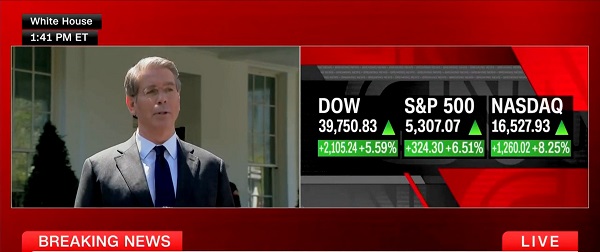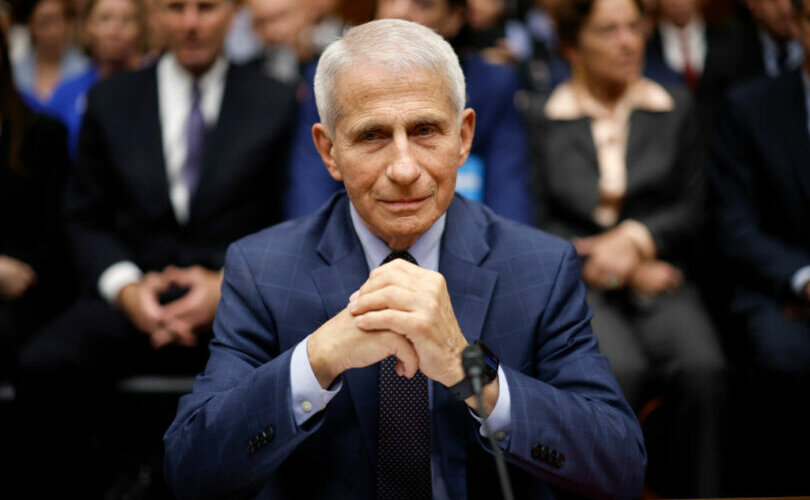Daily Caller
Reality Finally Returns To Energy Industry


From the Daily Caller News Foundation
By David Blackmon
Speaking at the opening day of the annual CERAWeek global energy industry gathering in Houston, Saudi Aramco CEO Amin Nasser declared plans for a government subsidized energy transition a failure, saying, “there is more chance of Elvis speaking next than the current plan working!”
He isn’t wrong, and Elvis was nowhere in sight.
Nasser began his speech by telling the audience made up largely of executives in the oil and gas industry and its contractors that, “We can all feel the winds of history in our industry’s sails again.”
Again, he isn’t wrong.
The winds of change have been blowing for well over a year now in favor of placing national energy security concerns over the rank climate alarmism that dominates the narratives surrounding this mythical transition. In fact, that shift began to become apparent at the 2023 CERAWeek gathering, as speaker after speaker emphasized the need to refocus on enhancing energy security after three years and trillions of dollars in debt-funded spending on renewables.
Now, with last November’s re-election of Donald Trump to a second presidency and the Energy Dominance agenda he brings with him, the momentum at the industry’s back is starkly obvious.
But that doesn’t mean that the world will or should abandon the expansion of other forms of energy, including intermittent sources like solar power and stationary batteries.
In this area, Nasser echoed the “all-of-the-above philosophy touted earlier in the Monday agenda by U.S. Energy Secretary Chris Wright, emphasizing a new model that “reflects the reality of growing demand and energy addition,” while bringing an end to the current practice by many activists and politicians of demonizing oil, gas, and coal.
“Ladies and Gentlemen, the world was promised many things in the current transition plan,” Nasser said. “It was like promising an energy El Dorado. And this quest was equally doomed to fail.”
Noting that the chosen alternatives to fossil fuels currently being heavily subsidized — wind, solar, green hydrogen, and electric vehicles — are unable to even account for incremental energy demands, much less replace fossil fuels, Nasser advocated for a revised effort in which alternatives play a growing role of complementing reliable, conventional energy sources. “I take no pleasure in this. But it is time to stop reinforcing failure. Indeed, as the fictions of the promised transition finally wash away, there is an historic opportunity to change course.”
Nasser’s remarks were largely echoed by Secretary Wright, who promised, “The Trump administration will end the Biden administration’s irrational, quasi-religious policies on climate change that imposed endless sacrifices on our citizens.” Wright also dismissed the previous administration’s focus on climate alarmism over energy security as myopic.
“The Trump administration will treat climate change for what it is — a global physical phenomenon that is a side effect of building the modern world,” Wright said. The energy secretary called Biden’s policies “economically destructive to our businesses and politically polarizing. The cure was far more destructive than the disease.”
Wright also bluntly explained why the Trump administration singled out offshore wind as an especially destructive element of the Biden myopia, while at the same time extolling solar and battery storage as zero-emission ideas that make sense.
Offshore wind’s “incredibly high prices, incredibly huge investment and a large footprint on the local communities, so it’s been very unpopular for people that live near offshore wind turbines,” Wright said. Touting his “all-of-the-above” approach, Wright said the administration supports anything that adds to “affordable, reliable, secure energy,” adding, “Wind has been singled out because it’s had a singularly poor record of driving up prices.”
Emphasizing the inadequacies of the subsidized alternatives to fossil fuels, Wright pointed out that there “is simply no physical way that wind, solar and batteries could replace the myriad uses of natural gas.” He also pointed out that gas currently supplies 43% of power generated on the U.S. grid, a share that is unlikely to be reduced anytime soon.
It all boils down to the simple reality that globalist plans for this government-forced transition have failed. As Nasser said, the time to “stop reinforcing failure” has arrived.
Elvis has left the building.
David Blackmon is an energy writer and consultant based in Texas. He spent 40 years in the oil and gas business, where he specialized in public policy and communications.
Daily Caller
AI Needs Natural Gas To Survive


From the Daily Caller News Foundation
By David Blackmon
As recent studies project a big rise in power generation demand from the big datacenters that are proliferating around the United States, the big question continues to focus in on what forms of generation will rise to meet the new demand. Most datacenters have plans to initially interconnect into local power grids, but the sheer magnitude of their energy needs threatens to outstrip the ability of grid managers to expand supply fast enough.
This hunger for more affordable, 24/7 baseload capacity is leading to a variety of proposed solutions, including President Donald Trump’s new executive orders focused on reviving the nation’s coal industry, scheduled to be signed Tuesday afternoon. But efforts to restart the permitting of new coal-fired power plants in the US will require additional policy changes, efforts which will take time and could ultimately fail. In the meantime, datacenter developers find themselves having to delay construction and completion dates until firm power supply can be secured.
Datacenters specific to AI technology require ever-increasing power loads. For instance, a single AI query can consume nearly ten times the power of a traditional internet search, and projections suggest that U.S. data center electricity consumption could double or even triple by 2030, rising from about 4-5% of total U.S. electricity today to as much as 9-12%. Globally, data centers could see usage climb from around 536 terawatt-hours (TWh) in 2025 to over 1,000 TWh by 2030. In January, a report from the American Security Project estimated that datacenters could consume about 12% of all U.S. power supply.
Obviously, the situation calls for innovative solutions. A pair of big players in the natural gas industry, Liberty Energy and Range Resources, announced on April 8 plans to diversify into the power generation business with the development of a major new natural gas power plant to be located in the Pittsburgh area. Partnering with Imperial Land Corporation (ILC), Liberty and Range will locate the major power generation plant in the Fort Cherry Development District, a Class A industrial park being developed by ILC.
“The strategic collaboration between Liberty, ILC, and Range will focus on a dedicated power generation facility tailored to meet the energy demands of data centers, industrial facilities, and other high-energy-use businesses in Pennsylvania,” the companies said in a joint release.
Plans for this new natural gas power project follows closely on the heels of the March 22 announcement for plans to transform the largest coal-fired power plant in Pennsylvania, the Homer City generating station, into a new gas-fired facility. The planned revitalized plant would house 7 natural gas turbines with a combined capacity of 4.5 GW, enough power 3 million homes.
Both the Homer City station and the Fort Cherry plant will use gas produced out of the Appalachia region’s massive Marcellus Shale formation, the most prolific gas basin in North America. But plans like these by gas companies to invest in their own products for power needs aren’t isolated to Pennsylvania.
In late January, big Permian Basin oil and gas producer Diamondback Energy told investors that it is seeking equity partners to develop a major gas-fired plan on its own acreage in the region. The facility would primarily supply electricity to data centers, which are expected to proliferate in Texas due to the AI boom, while also providing power for Diamondback’s own field operations. This dual-purpose approach could lower the company’s power costs and create a new revenue stream by selling excess electricity.
Prospects for expansion of gas generation in the U.S. received a big boost in January when GE Vernova announced plans for a $600 million expansion of its manufacturing capacity for gas turbines and other products in the U.S. GE Vernova is the main supplier of turbines for U.S. power generation needs. The company plans to build 37 gas power turbines in 2025, with a potential increase to over 70 by 2027, to meet rising energy demands.
The bottom line on these and other recent events is this: Natural gas is quickly becoming the power generation fuel of choice to feed the needs of the expanding datacenter industry through 2035, and potentially beyond. Given that reality, the smart thing to do for these and other companies in the natural gas business is to put down big bets on themselves.
David Blackmon is an energy writer and consultant based in Texas. He spent 40 years in the oil and gas business, where he specialized in public policy and communications.
Business
Scott Bessent Says Trump’s Goal Was Always To Get Trading Partners To Table After Major Pause Announcement


From the Daily Caller News Foundation
By
Secretary of the Treasury Scott Bessent told reporters Wednesday that President Donald Trump’s goal was to have major trading partners agree to negotiate after Trump announced a 90-day pause on reciprocal tariffs for many countries after dozens reached out to the administration.
Trump announced the pause via a Wednesday post on Truth Social that also announced substantial increases in tariffs on Chinese exports to the United States, saying 75 countries had asked to talk. Bessent said during a press event held alongside White House press secretary Karoline Leavitt that Trump had obtained “maximum leverage” to get trading partners to negotiate with the April 2 announcement of reciprocal tariffs.
“This was his strategy all along,” Bessent told reporters during an impromptu press conference at the White House. “And that, you know, you might even say that he goaded China into a bad position. They, they responded. They have shown themselves to the world to be the bad actors. And, and we are willing to cooperate with our allies and with our trading partners who did not retaliate. It wasn’t a hard message: Don’t retaliate, things will turn out well.”
Dear Readers:
As a nonprofit, we are dependent on the generosity of our readers.
Please consider making a small donation of any amount here.
Thank you!
WATCH:
China imposed retaliatory tariffs on American exports to the communist country Wednesday, imposing an 84% tariff on U.S. goods after Trump responded to a 34% tariff by taking American tariffs to 104%.
“Based on the lack of respect that China has shown to the World’s Markets, I am hereby raising the Tariff charged to China by the United States of America to 125%, effective immediately,” Trump said. “At some point, hopefully in the near future, China will realize that the days of ripping off the U.S.A., and other Countries, is no longer sustainable or acceptable.”
“They kept escalating and escalating, and now they have 125% tariffs that will be effective immediately,” Bessent said during the press conference.
Bessent said that China’s actions would not harm the United States as much as it would their own economy.
“We will see what China does,” Bessent said. “But what I am certain of, what I’m certain of, is that what China is doing will affect their economy much more than it will ours, because they have an export-driven, flood the world with cheap export model, and the rest of the world now understands.”
The Dow Jones Industrial average closed up 2,962.86 points Wednesday, with the NASDAQ climbing by 1,755.84 points and the S&P 500 rising 446.05 points, according to FoxBusiness.
-

 2025 Federal Election2 days ago
2025 Federal Election2 days agoPPE Videos, CCP Letters Reveal Pandemic Coordination with Liberal Riding Boss and Former JCCC Leader—While Carney Denies Significant Meeting In Campaign
-

 2025 Federal Election1 day ago
2025 Federal Election1 day agoNo Matter The Winner – My Canada Is Gone
-

 2025 Federal Election1 day ago
2025 Federal Election1 day agoASK YOURSELF! – Can Canada Endure, or Afford the Economic Stagnation of Carney’s Costly Climate Vision?
-

 2025 Federal Election1 day ago
2025 Federal Election1 day agoInside Buttongate: How the Liberal Swamp Tried to Smear the Conservative Movement — and Got Exposed
-

 Alberta1 day ago
Alberta1 day agoProvince to expand services provided by Alberta Sheriffs: New policing option for municipalities
-

 Alberta1 day ago
Alberta1 day agoMade in Alberta! Province makes it easier to support local products with Buy Local program
-

 2025 Federal Election1 day ago
2025 Federal Election1 day agoCSIS Warned Beijing Would Brand Conservatives as Trumpian. Now Carney’s Campaign Is Doing It.
-

 COVID-1917 hours ago
COVID-1917 hours agoCOVID virus, vaccines are driving explosion in cancer, billionaire scientist tells Tucker Carlson








